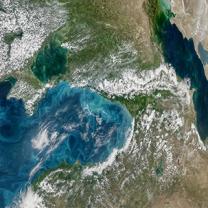Life from Above
Life from Above

-
Premiered:
- Network: PBS
- Category: Series
- Genre: Documentary
- Type: Live Action
- Concept:
- Subject Matter: Animal
- Tags:
Plot Synopsis
LIFE FROM ABOVE is a four-part documentary series that tells the unique, intimate and astounding stories of our planet from a perspective that few ever see -- from space. This extraordinary viewpoint reveals amazing events happening every day in both the natural and human worlds. From the intimate to the epic, the surprising to the familiar, this series offers a rare look at Earth, its landscapes and its inhabitants that goes beyond what we thought we knew. Episodes include:
"Moving Planet" (Wednesday, October 23, 2019 at 10pm): From space, Earth may appear still, but a look closer shows it is constantly on the move. In the first part of the series, cameras explore the powerful forces that create this restless movement. From above, watch the atmosphere swirl as devastating hurricanes hit the Gulf Coast of the United States, while in Africa, the lives of a family of elephants are saved by the long-awaited arrival of the rains. The journey of water has created the greatest delta on Earth, the Sundarbans, where fishermen respond to the ebb and flow of the tides, while in the center of Africa, hippos have channeled the water's flow to create a vast wetland. It's not only natural forces that are at work on our planet. Satellite cameras are so advanced that now the movement of animals and even people can also be seen from space. From above, satellites capture gray whales making their journey from Alaska to breed in the waters off California. Herds of wildebeest are caught crossing the Serengeti. In China, satellites spot the red shapes created by the synchronised display of thousands of Shaolin Kung-Fu students.
"Colored Planet" (Wednesday, October 30, 2019 at 10pm): We think of Earth as a blue planet, but now satellites allow us to look closer, revealing a kaleidoscope. Part two of the series, explores the secrets of our home's beautiful colors. Microscopic plankton transform the oceans with vast swirls of turquoise; only visible from above, these blooms support oceanic food chains. On land, seasonal blooms create incredible colors across the planet, from red chillies in the Gobi Desert to rainbow barcode fields of tulips in the Netherlands. In China, billions of rapeseed flowers turn the landscape bright yellow, followed by nomadic beekeepers who time their arrival with the blooms to harvest and sell honey. Where there is color, there is life, but a loss of color can be a sign that the natural world is under threat. In Australia, the bleaching of the barrier reef is now so advanced, it can be seen from space. In Greenland, the white of the ice sheet is specked with blue as climate change melts the ice, creating huge pools of sapphire. Being able to spot color from above allows scientists to monitor the most remote places of the planet, and this has led to a surprising discovery. In Antarctica, brown patches are guano trails left by emperor penguin colonies. By looking for these patches, more colonies of emperor penguins have now been discovered.
"Patterned Planet" (Wednesday, November 6, 2019 at 10pm): The third installment explores the mesmerizing array of shapes and patterns that cover Earth's surface, each with its own unique story to tell. In Australia, reef halos are the work of feeding fish, and in the continent's arid south, wombats have created their own network of burrows clearly visible from space. Satellite images also capture forest elephants mining for minerals in the earth, clearing a huge tear in the Congo's forest canopy. The impact of powerful natural forces on the planet can also be seen from space. For example, in Brazil, animals arrive as a sea of sand dunes is transformed by the rains. Cameras uncover u-shaped oxbow lakes that make the perfect safe place for rescued Amazonian manatees in need of rehabilitation. Animals and natural forces have been shaping the landscape for millennia, but recently, new, complex and ordered shapes crafted by humans have started to appear. Circles cover the Midwestern United States on a scale only appreciated from above. Satellites reveal small spaces in one of the many tightly packed irrigation crop circles where tiny bobwhite quail chicks have made a home.
"Changing Planet" (Wednesday, November 13, 2019 at 10pm): Earth is constantly in flux. The finale reveals the powerful forces that are changing and shaping the planet's landscapes. Ancient scars can be seen from above; the San Andreas Fault, Grand Canyon and Uluru have all been formed over thousands of years. The safest way to monitor one of the deadliest forces for change is from above. Volcanoes create new land in the South Pacific, but in South America, they put an endangered population of frogs on the brink of extinction. Seasonal changes are also powerful enough to leave their mark. Wildfires rip across California, creating black scars hundreds of miles across. Satellites have now become the best way to track the fires, monitoring the speed and direction of the smoke plumes and guiding smoke jumpers into the heart of the blaze. Now, there is a new force for change that is radically altering the planet: humans. Using images taken over decades, we can watch as cities sprawl and great forests disappear, but we can also see where we are trying to restore the balance. In Tanzania, local people have been using satellite images to replant trees to ensure a bright future for a group of chimpanzees.
Cast
- Corey Johnson - Narrator
Production & Distribution
- Produced by BBC Studios

